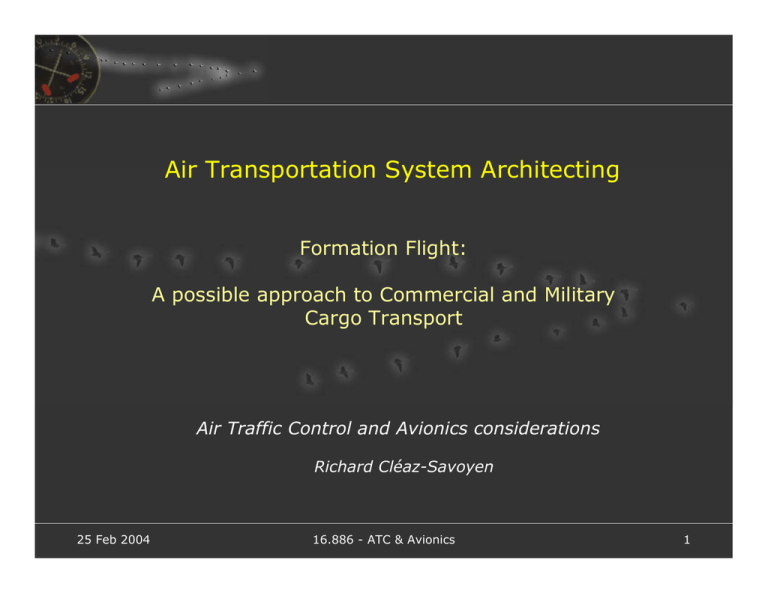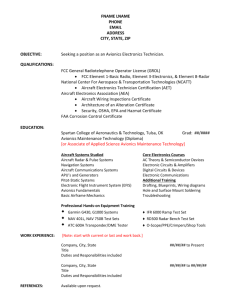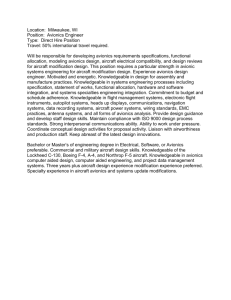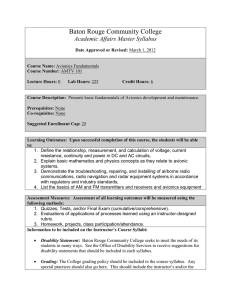Air Transportation System Architecting Formation Flight: Cargo Transport
advertisement

Air Transportation System Architecting Formation Flight: A possible approach to Commercial and Military Cargo Transport Air Traffic Control and Avionics considerations Richard Cléaz-Savoyen 25 Feb 2004 16.886 - ATC & Avionics 1 Agenda Ó Formation Flight in History Ó Military procedures Ó Operations optimization Ó Avionics - GPS Source: www.archives.gov 25 Feb 2004 16.886 - ATC & Avionics 2 Berlin Airlift June 25th 1948 -> August 1st 1949 9 2,223,000 tons of supplies 9 266,600 flights from West Germany 9 20 crashes among the British aircraft Source: www.usafe.af.mil 25 Feb 2004 16.886 - ATC & Avionics 3 Military procedures FAA – DOD Air Traffic Publications Order 7610.4J Special Military Operations Order 7110.65N Air Traffic Control Section 12. FORMATION FLIGHT Chapter 9: SPECIAL FLIGHTS FF DEFINITION: More than one aircraft which, by prior arrangement between the pilots, operate as a single aircraft with regard to navigation and position reporting. Separation between aircraft within the formation is the responsibility of the flight leader and the pilots of the other aircraft in the flight. This includes transition periods (join up and break away). Standard Formation: < 1 mile laterally or longitudinally < 100 feet vertically Nonstandard Formation: under the provisions of a letter of agreement. Ó Standard separation criteria are applied between the formation envelope and non-participating aircraft Ó Formation join-up and breakaway are conducted in VFR weather conditions unless prior authorization has been obtained Source: www2.faa.gov 25 Feb 2004 16.886 - ATC & Avionics 4 Military procedures General considerations in military FF Ó The Leader aircraft is responsible for the communications with ATC Ó Other aircraft fly relative to another one, and do not care of outside the cell Ó The aircraft use mainly VFR, visual clues for positioning themselves in the vortex and keep the position Ó The aircraft must be ready to communicate with ATC if FF breaksaway to get clearances to transition from formation to individual routes and altitudes Ó ADS-B may be turned-off in commercial aircrafts flying in Formation Source: Rob Holmes 25 Feb 2004 16.886 - ATC & Avionics 5 Operations phases Basically inefficient relative to the fuel savings Takeoff From same airport From different airports En-Route Break-away and Join-up Advantages Landing In same airport 25 Feb 2004 In different airports 16.886 - ATC & Avionics 6 Operations Takeoff from 1 airport Drawbacks Ó 2 minutes separation Ó Airborne waiting -> wastes fuel savings Potential solutions: Ó Use ll runways Ó Wide runway (Bangor,ME = 90m = 300ft) Ó Climb at different vertical speed to save fuel 25 Feb 2004 16.886 - ATC & Avionics 7 Operations Takeoff from n airports Tasks: Ó The aim is to avoid waiting at the rendezvous point -> wastes fuel Ó Departures timing at the minute Ó Rendezvous point optimized A B Problems: Ó Airports congestion C Ó Weather Needs real-time coordination (A/C-A/C; A/C-ATC; ATC-ATC) 25 Feb 2004 16.886 - ATC & Avionics 8 Operations En-Route Advantages: Ó Separation between the formation and the non-participating A/C remains the same Ó Increases Airspace Capacity from p to p+n-1 Real Benefits Drawbacks: Ó Break-away and join-up -> to be avoided (Fuel & ATC) Ó Airport break-away handling (workload increases) 25 Feb 2004 16.886 - ATC & Avionics 9 Operations Landing In one airport: Drawbacks: Ó Formation break-away to handle Ó Separation to avoid vortex problem -> holding -> wastes fuel Ó Airports congestion Solutions: Ó Optimum: landing in formation (wide runways) Ó Use ll runways Ó Descend at different vertical speed In different airports: No specific considerations 25 Feb 2004 16.886 - ATC & Avionics 10 Avionics - GPS State of the art: precision=2m Ó < 30 cm precision Requirements to optimize FF Ó Real time, time accuracy Ó Integrity and availability Carrier Phase differential GPS (NASA) Ó Based on the Doppler phenomenon Ó Measurement of difference of phase ∆Φ Ó Algorithms can compute the integer ß Precision: about 5 cm Sources: G. Larson, MIT 16.324, http://www.dfrc.nasa.gov 25 Feb 2004 16.886 - ATC & Avionics 11 Avionics - GPS Ó 3-D case: 4 satellites needed 3-D vector of relative position Ó Coupling with Inertial Measurement Unit Attitude and relative position known with high precision Possible redundancy using Galileo? Source: Greg Larson 25 Feb 2004 16.886 - ATC & Avionics 12 Conclusions Ó Efficient to 9 reduce ATC workload 9 increase Airspace capacity Ó But join-up and break-away phases will waste fuel Ó Avionics: GPS for automated assistance Acknowledgement: Robert Holmes, Technical Instructor, Naval science, MIT 25 Feb 2004 16.886 - ATC & Avionics 13 Air Transportation System Architecting Formation Flight: A possible approach to Commercial and Military Cargo Transport Air Traffic Control and Avionics considerations Richard Cléaz-Savoyen 25 Feb 2004 16.886 - ATC & Avionics 14 WWII Bombers Diverse formation shapes Source: www.archives.gov 25 Feb 2004 16.886 - ATC & Avionics 15 Avionics - GPS Carrier Phase differential GPS (NASA) Source: Greg Larson & MIT 16.324 25 Feb 2004 16.886 - ATC & Avionics 16



